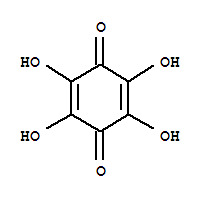| Identification |
| Name: | 2,5-Cyclohexadiene-1,4-dione,2,3,5,6-tetrahydroxy- |
| Synonyms: | Quinone,tetrahydroxy- (4CI);p-Benzoquinone, 2,3,5,6-tetrahydroxy- (8CI);p-Benzoquinone, tetrahydroxy- (6CI,7CI);2,3,5,6-Tetrahydroxy-1,4-benzoquinone;2,3,5,6-Tetrahydroxy-2,5-cyclohexadiene-1,4-dione;2,3,5,6-Tetrahydroxy-p-benzoquinone;2,3,5,6-Tetrahydroxybenzoquinone;HPEK-1;Kelox;NSC 112931;THQ;Terasin;Tetrahydroxy-1,4-benzoquinone;Tetrahydroxy-p-benzoquinone;Tetrahydroxy-p-quinone;Tetrahydroxybenzoquinone;Tetrahydroxyparabenzoquinone;Tetrahydroxyquinone;Tetroquinone; |
| CAS: | 319-89-1 |
| EINECS: | 206-275-5 |
| Molecular Formula: | C6H4O6 |
| Molecular Weight: | 172.09 |
| InChI: | InChI=1/C6H4O6/c7-1-2(8)4(10)6(12)5(11)3(1)9/h7-8,11-12H |
| Molecular Structure: |
 |
| Properties |
| Melting Point: | 300 deg C |
| Density: | 2.609 g/cm3/sup> |
| Stability: | Stable. Incompatible with strong oxidizing agents, strong bases. |
| Refractive index: | 2.023 |
| Water Solubility: | Slightly soluble in cold water |
| Solubility: | Slightly soluble in cold water |
| Appearance: | penetrating odor black Solid |
| Specification: |
The Tetrahydroxyquinone, with the CAS registry number 319-89-1 and EINECS registry number 206-275-5, has the systematic name of 2,3,5,6-tetrahydroxycyclohexa-2,5-diene-1,4-dione. It is a kind of blue-black crystals, and belongs to the following categories: Anthraquinones, Hydroquinones and Quinones. It is very stable, but incompatible with strong oxidizing agents or strong bases. The molecular formula of the chemical is C6H4O6.
The characteristics of Tetrahydroxyquinone as followings: (1)ACD/LogP: -2.18; (2)# of Rule of 5 Violations: 0; (3)ACD/LogD (pH 5.5): -6.88; (4)ACD/LogD (pH 7.4): -8.37; (5)ACD/BCF (pH 5.5): 1; (6)ACD/BCF (pH 7.4): 1; (7)ACD/KOC (pH 5.5): 1; (8)ACD/KOC (pH 7.4): 1; (9)#H bond acceptors: 6; (10)#H bond donors: 4; (11)#Freely Rotating Bonds: 4; (12)Polar Surface Area: 71.06 Å2; (13)Index of Refraction: 2.023; (14)Molar Refractivity: 33.48 cm3; (15)Molar Volume: 65.9 cm3; (16)Polarizability: 13.27×10-24cm3; (17)Surface Tension: 321.9 dyne/cm; (18)Density: 2.609 g/cm3; (19)Flash Point: 192.1 °C; (20)Enthalpy of Vaporization: 71.45 kJ/mol; (21)Boiling Point: 370.6 °C at 760 mmHg; (22)Vapour Pressure: 5.3E-07 mmHg at 25°C.
You should be cautious while dealing with this chemical. It irritates to eyes, respiratory system and skin. Therefore, you had better take the following instructions: Wear suitable protective clothing, and if in case of contacting with eyes, rinse immediately with plenty of water and seek medical advice.
Addtionally, the following datas could be converted into the molecular structure:
(1)SMILES: O=C1C(/O)=C(/O)C(=O)C(\O)=C1\O
(2)InChI: InChI=1/C6H4O6/c7-1-2(8)4(10)6(12)5(11)3(1)9/h7-8,11-12H
(3)InChIKey: DGQOCLATAPFASR-UHFFFAOYAF
|
| Storage Temperature: | Keep container closed when not in use. Store in a tightly closed container. Store in a cool, dry, well-ventilated area away from incompatible substances. |
| Usage: | Disodium salt is used as an indicator in the volumetric determination of sulfate by means of barium chloride solution. |
| Safety Data |
| Hazard Symbols |
 Xi: Irritant
Xi: Irritant
|
| |
 |